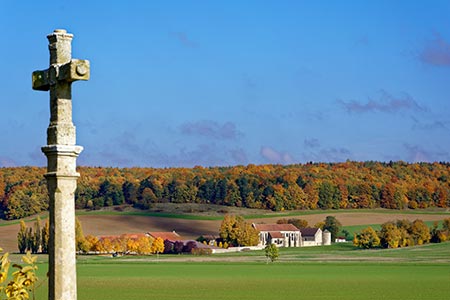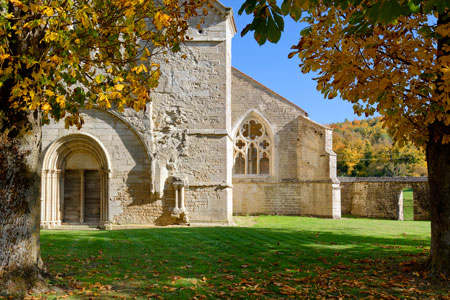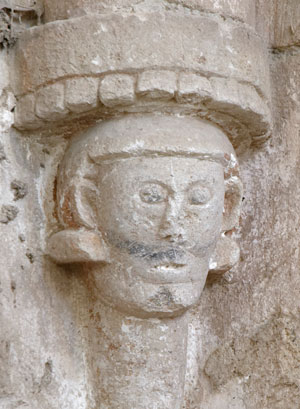Un patrimoine médiéval préservé
Un lieu d'échanges et d'études
 L’ordre du Temple créé à l’initiative de chevaliers venus en Orient avec les croisades au début du XIIe siècle, est reconnu comme un ordre religieux par l’Église romaine en 1129 lors d’un concile réuni à Troyes. Ayant pour mission de protéger les pèlerins se rendant à Jérusalem et défendre militairement les États latins d’Orient créés après la première croisade, l’ordre devait mobiliser d’importantes ressources humaines, matérielles, financières, qu’il ne pouvait trouver qu’en Occident. À cet égard, Épailly est un remarquable exemple de ce qu’étaient une maison et un domaine de « l’arrière » templier.
L’ordre du Temple créé à l’initiative de chevaliers venus en Orient avec les croisades au début du XIIe siècle, est reconnu comme un ordre religieux par l’Église romaine en 1129 lors d’un concile réuni à Troyes. Ayant pour mission de protéger les pèlerins se rendant à Jérusalem et défendre militairement les États latins d’Orient créés après la première croisade, l’ordre devait mobiliser d’importantes ressources humaines, matérielles, financières, qu’il ne pouvait trouver qu’en Occident. À cet égard, Épailly est un remarquable exemple de ce qu’étaient une maison et un domaine de « l’arrière » templier.
 Implantée aux limites de la Bourgogne et de la Champagne, qui furent le berceau de l’ordre du Temple en Occident, la maison d’Épailly, sans doute existante à l’extrême fin du XIIe siècle, reçut des seigneurs de la région des biens nombreux et variés qui permettent de la considérer en 1214 comme la « maison de la chevalerie du Temple qu’on appelle Épailly », soit une commanderie, structure de base dans l’organisation territoriale templière; la splendide chapelle gothique, érigée en ce début du XIIIe siècle, atteste par son ampleur, de son importance. Les donations et les achats se poursuivent au XIIIe siècle : un inventaire dressé en 1308, peu après le début de l’affaire du Temple, donne un aperçu très concret des terres, redevances, droits et justices rassemblés par les frères du Temple autour d’Épailly, avec principalement les villages proches de Courban, Bissey-la-Côte, Louesmes et Layer.
Implantée aux limites de la Bourgogne et de la Champagne, qui furent le berceau de l’ordre du Temple en Occident, la maison d’Épailly, sans doute existante à l’extrême fin du XIIe siècle, reçut des seigneurs de la région des biens nombreux et variés qui permettent de la considérer en 1214 comme la « maison de la chevalerie du Temple qu’on appelle Épailly », soit une commanderie, structure de base dans l’organisation territoriale templière; la splendide chapelle gothique, érigée en ce début du XIIIe siècle, atteste par son ampleur, de son importance. Les donations et les achats se poursuivent au XIIIe siècle : un inventaire dressé en 1308, peu après le début de l’affaire du Temple, donne un aperçu très concret des terres, redevances, droits et justices rassemblés par les frères du Temple autour d’Épailly, avec principalement les villages proches de Courban, Bissey-la-Côte, Louesmes et Layer.

En 1307, le roi de France fait arrêter les templiers de son royaume et saisir leurs biens. À la suite d’une longue procédure, l’ordre du Temple est supprimé en 1312 et ses biens remis à l’ordre des hospitaliers de Saint Jean de Jérusalem, depuis peu installé dans l’île de Rhodes. Celui-ci toutefois n’entre réellement toutefois en possession d’Épailly qu’en 1328. La commanderie va jouer un rôle important dans la vie de cet ordre avec la formation du prieuré de Champagne, par démembrement du grand prieuré de France. L’un des premiers prieurs de Champagne, Ferry de Fougerolles réside à Épailly et est inhumé dans la chapelle. D’autres grands prieurs y éliront domicile et des chapitres généraux du prieuré s’y réuniront épisodiquement. Guerre de Cent ans oblige, le domaine est fortifié.
On connaît ensuite l’histoire d’Épailly par les procès-verbaux des visites prieurales effectuées irrégulièrement durant les trois siècles de l’époque moderne. La description des lieux, des bâtiments, des réparations ou des démolitions en constituent le fonds. L’on suit particulièrement le destin de la chapelle, dont la vaste nef à six travées est unique parmi les constructions similaires des templiers et hospitaliers. Menacée de destruction, mise à mal par sa vente comme bien national à la Révolution mais finalement sauvée par son utilisation comme grange dans le grand domaine agricole dont elle est le centre, la chapelle fut inscrite à l’inventaire des monuments historiques au XXe siècle, et sa restauration est en cours.
Alain Demurger
Maître de conférences honoraire à l'université de Paris I Panthéon-Sorbonne
The order of the Temple, created on initiative of knights who came to the Orient with the crusades at the beginning of the 12th century, was recognized as a religious order by the Roman Church in 1129 during a council meeting in Troyes. Invested with the mission of protecting pilgrims going to Jerusalem and of ensuring the military defense of the Latin States of the Orient, the Order was created after the first crusade. The order had to mobilize important human, material and financial resources, which could only be found in the Christian West. In that sense, Épailly is a remarkable example of what was considered to be a commandery and an estate characteristic of the « homefront » of the Knights Templar.
Located on the borders of Burgundy and Champagne, which were the birthplace of the Order of the Temple in Western Europe, the estate of Épailly, the existence of which is problably previous to the end of the 12th century, was endowed with numerous and varied properties by lords and knights originating from the region. The estate can rightfully be identified as the one designated in a document dating from 1214 as the "house of the chivalry of the Temple which is called Épailly". In other words, it actually corresponds to a commandery, the core structure in the territorial organization of the Order of the Temple. The splendid Gothic chapel was erected at the start of the 13th century. The size of the chapel is an evidence of its importance. Donations and purchases continued throughout the 13th century: an inventory drawn up in 1308, shortly after the beginning of the Temple affair, drew a very accurate overview of the land, royalties, duties and juristictional taxations levied by the knights of the Temple around Épailly in an area encompassing mainly the villages situated near Courban, Bissey-la-Côte, Louesmes and Layer.
In 1307, the King of France had the Templars of his kingdom arrested and their property seized. Following a lengthy procedure, the order of the Temple was abolished in 1312 and its property returned to the order of the Hospitallers of Saint John of Jerusalem, that had recently settled on the island of Rhodes. The latter, however, did not really come into possession of Épailly until 1328. The commandery played an important role in the life of this order through the constitution of the priory of Champagne that followed the dismemberment of the former grand priory of France of the Order of the Temple. One of the first priors of Champagne, Ferry de Fougerolles, lived in Épailly and was buried in the chapel. Other grand priors will take up residence there and general chapters of the priory will meet there from time to time. Due to the Hundred Years War, fortifications were built in the area.
The history of Épailly can be henceforth traced from the reports of the prioral visits that were held irregularly during the three centuries timespan which constitutes the Modern Times (XVIth to XVIIIth centuries). The description of places, buildings, repairs or demolitions makes up their contents. We follow closely the fate of the chapel, the vast nave of which is comprised of six bays. It is unique among similar constructions of the Knights Templars and Hospitallers. Threatened with destruction, damaged after being sold as national property during the Revolution before it was eventually saved as a barn located at the heart of the large agricultural estate of which it was its central element, the chapel was listed in the inventory of historic monuments of France in the 20th century, and its restoration is in progress.



